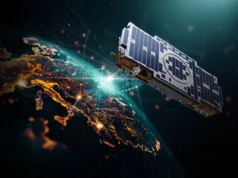OneWeb, the communications company building a Low Earth Orbit (LEO) satellite constellation to deliver global connectivity, has achieved a major step in its reorganisation process.
On the 2nd of October 2020, the United States Bankruptcy Court for the Southern District of New York confirmed OneWeb’s Chapter 11 plan of reorganisation, ensuring that the company remains on target to resume full business operations imminently.
“The Plan details a strong operational foundation for the company to deploy the initial 650 LEO satellite constellation under the new ownership of the UK Government and Bharti Global Limited (“Bharti”).
The transactions outlined in the Plan will be implemented following receipt of customary regulatory approvals, which are expected by the end of 2020. In the meantime, OneWeb is resuming operations and readying its commercial services which are planned to start next year.”
Adrian Steckel, Chief Executive Officer of OneWeb, stated:
“As we await the final mechanical components of the transaction, we set our eyes back to the skies with the resumption of launches later this year and commencing commercial services within a year. We are working closely with HMG and Bharti and are pleased with their commitment and partnership as we remain ever-focused on our mission to bring connectivity to communities and people around the world.”
According to NASASpaceFlight.com, the OneWeb constellation was built and designed to be a broadband internet space-based service, providing internet to rural and urban areas that lack the infrastructure for internet connections or to provide an alternative to existing services. However, one of the confusing elements of the purchase is arguably the announcement from the UK government that they wish to use OneWeb as a space-based navigation system – something it was not designed to do.
“The decision for the U.K. government to purchase OneWeb came with few details about when satellite launches will resume and exactly what the OneWeb satellites will now be used for and even who will have access to them once launched.”












Me thinks the best way forward would be to go ahead with the current constellation unchanged and plan for a properly specified, designed and de-risked second constellation at a more appropriate orbit for satnav.
This would mean either ‘gapping’ capabilities in the short term or ‘renting capacity on someone else’s network, if possible.
I actually think such an an approach would be quicker at delivering a national satnav capability that works i.e. fit for purpose. Trying to shoe horn satnav onto an inappropriate constellation that is already partially deployed would require a lot of engineering compromises and from what I have read possible a compromise or two too far.
Also, sticking with the current business plan might see a quicker return on tax payers money…
Cheers CR
Yes, you are correct. Theoretically you can turn any communications satellite into a navigation satellite. The main issues would how it provide precise and synchronised timing. A simple quartz based clock won’t cut it, as its not accurate enough. The network of satellites will have a known path, so there approximate positions will be roughly known. If each satellite transmit a slight different pulse string for identification, these can be used to give a rough 2D plot. However, to get more accurate you will need to know their exact position, height and make sure the timing signal is synchronised. It won’t be simple to push for better accuracy or cheap, but it could be done. It would be far better to use a satellite built for the job, complete with an atomic clock, but then that’s going to cost.
Hi Daveyb,
I read a post on here some weeks ago that went into some detail about Satnav. Was that you? It certainly, explained a lot for me and was well written.
All too often people with non-technical backgrounds make unreasonable demands on engineers and scientists then wonder why the costs run away. So to the politicians (and I include uniformed politicians here) I say, “One, technology isn’t something that magically appears, it takes hard graft sometimes years of effort. Two, the laws of physics are unbreakable and getting close to the limits tends to really, really cost. So don’t ask for the impossible, perfection or even the best, ask for what is possible if it’s needed and keep it as simple as possible. That way it can be delivered on time, quickly and to cost.”
Sorry I spent too long with the MoD PE, DRA, DERA and finally QinetiQ working for the MoD and the idea of putting satnav on satellites intended from broadband kinda sums it up really 🙂
Cheers CR
There’s going to be a lot of focus on reducing the cost of accurate timekeeping, per SDA
“SDA’s Navigation Layer is exploring technical areas including, but not limited to:
https://www.sda.mil/navigation/
Hi CR. The reason for using LEO satellites for a major component in the US SDA program is resilience against potential interference with, or destruction of conventional GPS, communications and surveillance satellite assets at GEO/MEO, that are only present in much smaller numbers and cost more to build and launch versus micro-satellites.
Russia, for example has already launched satellites that have maneuvered close to US military satellites, posing a potential threat to them. Replacement of LEO satellites is much easier, cheaper and more rapid should they also be interfered with than conventional GEO/MEO assets. This would especially be true for the UK with a domestic small satellite launch capability that’s being developed.
Yes but as I told you last time SDA isnt looking to replace geostationary GPS satellites but to supplement it, they act as relays rebroadcasting the signals they receive from traditional GPS and ground stations to help circumvent jamming. They cant work alone.
Then I guess I have to post this again, which it seems you didn’t read above in my other post? It couldn’t be more clear.
“SDA’s Navigation Layer is exploring technical areas including, but not limited to:
– Low size, weight, power, and cost (SWaP-C) atomic clocks or other timekeeping systems, and
– Other hardware or software to support alternate PNT.”
https://www.sda.mil/navigation/
Yeah and if you actually read the project documents what they are refering to is on-chip atomic clocks not to be used for the generation of GPS signals (as it lacks the level of precision required for navigation signals) but to be used for calculating targeting data for the missile tracking function (e.g triangulating heat blooms) and for time stamping satellite to satellite optical communication links so they cant be dummied.
These on chip atomic clocks are already available commercially and only cost about $3000, they are used in military radars and commercial sonars as well as high precision GPS receivers. However they are about 1000th as accurate as a traditional atomic clock and while the the traditional type keep the same precision perpetually the on-chip type lose accuracy and need recalibrating after only a couple of years of use (starting at about 1.7 to the -11 in their first year or two in their third or fourth year they will be losing whole seconds) which makes them unsuitable at present for space applications where they cant be regularly replaced.
There isn’t a need for an absolute reference, accurate over time, for LEO satellites to function as an alternative GPS system. Short term clock accuracy in the LEO satellite can be extended to long term accuracy, provided there is an ability to correct for error/drift. Either the actual clock is corrected/synced/disciplined or the error is tracked and used to offset the clock error.
There are at least two ways to correct error/drift.
If traditional GPS satellites are disabled then LEO satellites can still reference the ground stations. Arguably routinely accessing both is likely to be more robust.
LEO satellites are likely to have something like 5 year lives. Depending on orbit height they will do a complete orbit of the Earth ~15 times per day (or ~100 minutes per orbit). The orbit then ‘travels’ laterally around the world, so its crossing the equator at different points each orbit. So how often a satellite can be time corrected will depend on the number of ground stations with reference clocks and the rate of orbit travel (in the absence of GPS satellites functioning), but it might be as often as multiple time checks per day. The UK could for example have ground station clocks at Ascension, Diego Garcia, Australia or NZ, Pitcairn and Falklands.
Microsemi is one example of a company producing chip atomic clocks for LEO space applications but SDA is clearly interested in exploring improvements.
https://www.microsemi.com/product-directory/embedded-clocks-frequency-references/5207-space-csac#overview
That’s the Tracking function. The Navigation function is what I am referring to.
If the US loses its GPS satellites and any in-orbit replacements, in part or in whole, then its effectively lost navigation and timing data potentially across its entire military, unless it resorts to third party positioning services at lower accuracy (assuming availability), INS or earth based chip atomic clock equipment. The Navigation function of SDA is intended to at least mitigate such a loss and hopefully dissuade an adversary attempting it in the first place. LEO satellites simply being repeaters for current GPS satellites doesn’t address this threat.
A LEO satellite derived GPS may not be as accurate in initial implementations (see my other reply to you on this topic) but it doesn’t preclude both system and source clock improvements to close any gap.
As I understand it the trickier bit with using LEO satellites for GPS is not the clock accuracies but each satellite knowing its position with sufficient accuracy. With conventional GPS having fewer satellites in higher orbits it is far easier to track their orbits pretty much constantly and update their positional coordinates from ground stations as necessary whereas with a much higher number of satellites orbiting much faster and I think at LEO also the orbital trajectories subject to more minor random perturbations meaning the onboard inertial positioning needs to be re-seeded more often creates a big and possibly insurmountable challenge. It’s very unclear whether LEO GPS satellites could maintain accurate enough positional data to be able to provide a level of accuracy to surface terminals that matches that currently offered by existing GPS constellations.
Similar to time corrections options for positional updates might be with reference to higher orbit GPS nodes that know their position with the required accuracy or in theory from ground stations but the later is far more tricky than with clock adjustment because positional updates are potentially needed multiple times per orbit for each satellite and with the number of satellites and range of orbits that means that a huge number of ground stations would be needed. Another possibility I suppose might be positioning updates by reference to other satellites in the LEO constellation that have had recent ground station updates but the current OneWeb satellites don’t have any inter-satellite links (as opposed to the SpaceX Starlink satellites that do).
Even though the sufficiently accurate LEO GPS bit looks challenging this OneWeb acquisition is still hugely exciting for the UK military simply in terms of the game-changing high bandwidth low latency worldwide connectivity that it will offer if successfully rolled out. Coincidentally Musk tweeted just yesterday in reply to a question about Starlink being “deployable on high-speed moving objects like trains”. His answer was “Yes. Everything is slow to a phased array antenna”. One wonders how far his definition of “everything” extends but maybe a future anti-ship or cruise missile being able to relay targeting/sensor data and take mid-course corrections anywhere in the world from anywhere in the world with <30mS latency? There are lots of possibilities such a worldwide network opens up and with the UK owning a golden share in terms of approving potential OneWeb customers or any changes in equity ownership the UK would I think be unique in the entire world in having such a state controlled capability. The USA would also have such a capability because it has already contracted with SpaceX for various military uses of Starlink but technically since SpaceX is a private company does that count as state controlled? I suppose in reality it does because I’d be quite surprised if the US government didn’t have many levers it could pull to stop SpaceX doing something deemed damaging to US national security (the craziest and obviously totally unrealistic example being to sell itself to the Russian or Chinese government for instance) so maybe in practice it will end up with the UK and the USA being the only countries on the planet to have such a capability. Pretty impressive if the UK can pull that off and see this through to its conclusion (which will take a lot more investment to complete I suspect).
I probably should caveat my comments with qualifications that some of this is by no means easy, or necessarily in the immediate near term.
As you point out the current GPS time and position is routinely validated and corrected if required, Jet Propulsion Labs’ GDGPS provides details. We shouldn’t assume the UK’s future GNSS service will be supported with the current LEO satellites, that seems very unlikely. But since LEO satellites will have a ~5 year life, then future satellites can support inter-satellite links and improving clocks, along with other capabilities.
The GDGPS system indicated above has a significant number of base stations for orbit and time correction. A separate UK system might for example use UK embassy and consulate locations as a first pass for such bases since they probably want the comms capability anyway, but locations don’t have to be limited to these, just as the GDGPS base stations aren’t.
LEO satellite based GNSS is more challenging than a MEO network. Indeed, there seem to be a lot of ‘experts’ that rule it out as possible. They apparently couldn’t wait in order to rush into print to say so. This is reminiscent of other ‘experts’ who said BEVs weren’t commercially possible, landing and re-use of rockets wasn’t possible, and LEO satellite broadband comms isn’t possible, or isn’t possible with low latency. Each time challenges have been overcome and they have been proved wrong, or to have had an agenda. I see LEO GNSS as no different.
I wonder who Bharti is controlled by and how they are connected to cummings.
https://en.m.wikipedia.org/wiki/Bharti_Airtel
Terrific. As if we don’t have enough tin-foil hat conspiracy theorists banging on about 5G/ scamdemic/ flat-earth we now have one obsessed with Cummings. ?♂️
if the virus can be sent via phone mast why cant the vaccine…… eek no reply as yet from those asked?
Just had a quick look at the link provided by Pete and Bharti’s website. They have just sold a 25% stake in one of their subsiduaries to The Carlyle Group for $1.2billion.
Bharti is big, really big! They were set up in 1976 in India by Sunil Bharti Mittal and have revenues of over $16billion.
They have set up another subsiduary in the Channel Islands to partner with HMG… Fills you with confidence don’t it!
Cheer CR
If the UK did nothing more than use OneWeb for its original purpose to implement a LEO communications network for commercial/residential service that still holds major promise, given the poor service even in some regions of the US where broadband commercial service is lacking. That the service can be sold to less affluent countries around the world, that are financially and geographically challenged with delivering service to rural and even urban regions is both a commercial and soft power benefit.
The upside is leveraging this LEO satellite capability to provide military focused services. The US SDA program directly addresses this goal. https://www.sda.mil/
One of the early focuses for LEO networks is the detection of hypersonic weapons. SpaceX and L3Harris were just awarded early contracts for this.
https://www.c4isrnet.com/battlefield-tech/space/2020/10/05/space-development-agency-orders-8-hypersonic-weapon-tracking-satellites/
100% agree. Apart from my thoughts above about transformational military capabilities it also adds another tool to the UK’s soft power toolkit in terms of subsidised or free internet connectivity to organisations considered appropriate and funded I assume out of the foreign aid budget. Providing broadband levels of internet connectivity to emergency field hospitals in disaster areas so that on-site medics can be augmented by remote consultations would be just one example.
And it’s not just foreign aid. The UK is still trying to meet the challenge of getting broadband coverage into all the less populated rural areas of our country. OneWeb could be an extremely valuable part of the solution there. In many cases I would think a far better solution than laying miles and miles of fibre to individual farmhouses in the middle of nowhere or building extra mobile masts to serve a handful of people each.
I likewise agree with your points. As you probably know, even with its current beta service, Starlink has supported wildfire areas in Washington where infrastructure has been destroyed, and remote Native American tribes where there has never been infrastructure in the first place. There are many other advanced economies with similar challenges before we even get to the less wealthy nations. As you point out wrt the UK, a location doesn’t have to be that remote before the cost of providing broadband through conventional means cannot be justified on purely economic grounds and where public funds always seem inadequate to bridge the gap.
Beyond emergencies, a low cost, low power satellite broadband capability can routinely support rural communities with remote child and adult education, telehealth, weather forecasting and farming guidance. It can also enable remote employment. I do hope that this capability is supported by foreign aid in due course.